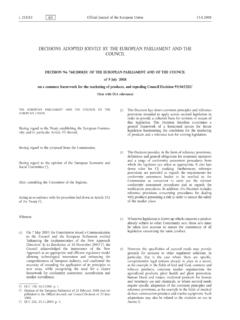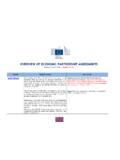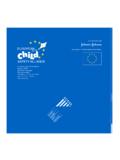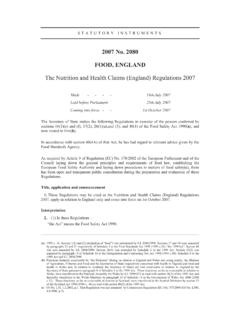Transcription of European Medicines Agency action plan related to …
1 30 Churchill Place Canary Wharf London E14 5EU United Kingdom An Agency of the European Union Telephone +44 (0)20 3660 6000 Facsimile +44 (0)20 3660 5545 Send a question via our website European Medicines Agency , 2017. Reproduction is authorised provided the source is acknowledged. 14 November 2017 EMA/680018/2017 Stakeholders and Communication Division EMA action plan related to the European Commission s recommendations on product information1 The European Medicines Agency (EMA) recognises the importance of the European Commission report2 and its recommendations to improve the EU product information. This represents a unique opportunity to improve the information EU patients receive on their Medicines , within the boundaries of the current legislation.
2 In order to meet high public expectations that the report has generated, it is important that any action is properly planned and executed, relevant stakeholders are involved and due consideration is given to the required expertise, timing and resources. The following is an analysis of the timelines, technicalities which will be needed to implement the necessary actions to meet the objectives set in the report. This analysis has not taken into account the impact of Brexit. However it needs to be noted that prioritisation, timelines and resource allocation will depend on how activities will be affected during the Agency s relocation and business continuity plan (BCP). The different actions are broken down by each of the Commission s recommendations: 1.
3 Room for improvement of package leaflet (PL) rather than summary of product characteristics (SmPC) As far as the PL is concerned, patients comprehension of the PL and its readability can be improved. The language used is often too complex and the design and lay-out are not always user-friendly. The elderly and those with low literacy skills are particularly disadvantaged, but generally these problems hold for all patient groups. On the other hand, fewer problems were identified with regard to the SmPC, although improvements can still be made, especially with regard to its readability. Representatives of healthcare professionals generally judge the quality of the SmPC as reasonable and value most of the current topics addressed in the SmPC as being important.
4 1 In accordance with Article 59(4) of Directive 2001/83/EC of the European Parliament and of the Council of 6 November 2001 on the Community code relating to medicinal products for human use 2 EMA action plan related to the European Commission s recommendations on product information0F EMA/680018/2017 Page 2/7 Recommendation: Generally, there should be more focus on improving the PL rather than the SmPC. However, for any potential improvement of the PL it should be also considered whether a corresponding or related change of the SmPC would be appropriate. 2. Amendments of guidelines and Quality Review of Documents (QRD) templates to enhance readability of PL Content and layout- related issues have been identified in the PIL-S Study.
5 It is considered that future work on guidelines relating to the PL, and possibly also the SmPC to some extent, has the potential to solve a number of these issues. Guidelines should include more details on the principles of good information design in which content and layout are jointly considered. This would help to ensure compliance with the legal requirement that the PL shall be "clearly legible". Moreover, improvements related to the language used would help to ensure that the information is "clear and understandable" as also required by the legislation. These issues could be best addressed by improving the existing guidelines, in particular the Readability Guideline, the Packaging Information Guideline and, where appropriate, the SmPC Guideline.
6 The relevance and importance of the QRD template is also acknowledged in this respect as it is the main tool to provide guidance to the industry in a harmonised way. The QRD template should rely on principles of good information design and pay attention also to the needs of some specific groups of patients, such as elderly, young people or people with mental illnesses. Small font size, narrow line spacing and the length of the PL were identified as the main issues. Guidelines and QRD templates are also considered too restrictive in some respects. They should allow for more flexibility to adapt the PL to the specificities of each product whilst respecting the limits provided by the legislation. Deletion of some information that is currently required by the QRD template, but that is of limited relevance for patients may allow more space to improve the content and layout of package leaflets and should, therefore, be considered.
7 More attention should also be paid to the translation of the user-tested PL into other languages. It is considered important to keep the lay-ness of the user-tested version when the leaflet is translated. Recommendation: It should be considered to revise the existing guidelines, in particular the Readability Guideline, the Packaging Information Guideline and, where appropriate, the SmPC Guideline to include principles of good information design and consider allowing more flexibility in the information recommended in the QRD template, as long as the relevant legislation allows it. These revisions should also include introduction of guidance on translations that go beyond the principle of faithful translation. Proposed actions Ensure that any change which is introduced to the PL is applied to the SmPC as needed.
8 Timelines In parallel to the whole project implementation. EMA action plan related to the European Commission s recommendations on product information0F EMA/680018/2017 Page 3/7 The aim should be to ensure that the lay language introduced through user testing in the original language version is not lost during translation. Proposed actions In order to achieve valid results, there is first a need to establish areas for improvement and revision, which must be endorsed by stakeholders. In order to identify such areas, EMA will need to work with experts and stakeholders to understand well the problems and concerns and explore the possible options. Review Readability Guideline; Review SmPC Guideline (to ensure adequate alignment with the PL see recommendation 1); Review QRD template; Produce guidance on translations.
9 Technical requirements Involvement of external experts, including academic experts (on benefit/risk communication, on linguistic matters, especially in the field of translation, etc.); Incorporation of principles of good information design in guidelines (by use of academic expertise); Involvement of all stakeholders (patients, consumers, healthcare professionals, industry); Adequate public consultation; Possible stakeholder workshop; Need to work with Member States (and incorporate their input as well as existing initiatives at national level). Timelines Two years starting as soon as resources are available3. 3. Improving patient input in developing and testing of PLs The assessment recognised the usefulness of patient involvement and the importance of user testing of the PL.
10 It is equally important that methodology for such testing is well defined. The assessment further identified the need for strengthening the input from the patient perspective which could also help in getting more understanding on how to present benefit-risk information for a particular medicine. Recommendation: The input from patients during the process and the related methodology should be further improved, for example by considering the requirement to make the user testing process more iterative and to ensure that a sufficiently mature version of the PL is user-tested. This iterative user testing would be coordinated by regulatory authorities in parallel to the assessment in a way that does not disrupt the whole marketing authorisation process.


















